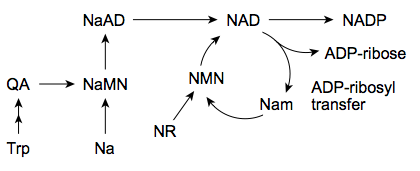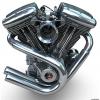Why buy nicotinamide riboside, which I believe is a precursor to the desired nicotinamide adenine dinucleotide (NAD+)?
Why not buy NAD+ itself?
NAD+ is available here and here.
There is a little more to this question, NAD is a large and chemically sensitive molecule.

The digestive system is also a rather harsh environment. If the NAD molecule could make it past the first hurdle of digestive absorption, it still has to gain access thru the cell membrane. All of the most recent research suggests the more complicated precursors get broken down at this hurdle including extracellular NAD. So it appears NMN and NADH and NAD get reduced at this barrier and get reassembled within the cell.

NR on the other hand has transport enzymes to assist in its absorption at the cell membrane.

PnuC transporters
"Only NR can be utilized by the PnuC transport system located in the inner membrane (Herbert et al., 2003; Sauer et al., 2004). The pnuC gene product is the protein that is responsible for the main flow of the NR substrate into the cytoplasm."
"Despite the considerable progress in the understanding of the mechanisms of NAD biosynthesis during the past decade, several fundamental questions still remain unanswered. So far, little is known about the molecular mechanisms underlying the interconversions of the key NAD intermediates and the relationships between their intra- and extracellular pools. Recent studies have established that all known NAD metabolites can serve as extracellular precursors of intracellular NAD (12). However, most likely, extracellular nucleotides need to be degraded to their corresponding ribosides (NR or NAR), which then enter cells as NAD precursors." http://www.jbc.org/c...664458.full.pdf
So it appears of the more complicated NAD precursors Nicotinamide Riboside and Nicotinic Acid Riboside are the simplest common denominators. We also posted on this topic last month. "There is more and more data accumulating that suggests NMN is cleaved to NR at the cell membrane and reassembled within the cell." "Our results demonstrate that, besides nicotinamide and nicotinic acid, only the corresponding nucleosides readily enter the cells. Nucleotides (e.g. NAD and NMN) undergo extracellular degradation resulting in the formation of permeable precursors."
So we are left with 4 NAD precursors that readily pass the cell membrane unchanged NaR, Na, Nam and NR. What gives NR or NaR (NaR if we could get it) a leg up on the other precursors is (NMRK1 & NMRK2) nicotinamide riboside kinase 1 or 2. These are expressed in varying degrees in different cell types but the point is they convert these 2 precursors directly to NMN which is one step away from NAD. So in effect these 2 precursors cut to the front of the line at the cell membrane and again inside the cell in the NAD salvage cycle. The salvage cycle is the circular part of the diagram below.

The question is what's to be gained by supplementing with a molecule which will in all likelihood be broken down before it gets to its destination? Also you have to consider the cost of NAD which is currently more than NR. Hope that helps.
Edited by Bryan_S, 02 October 2015 - 03:51 PM.



















































